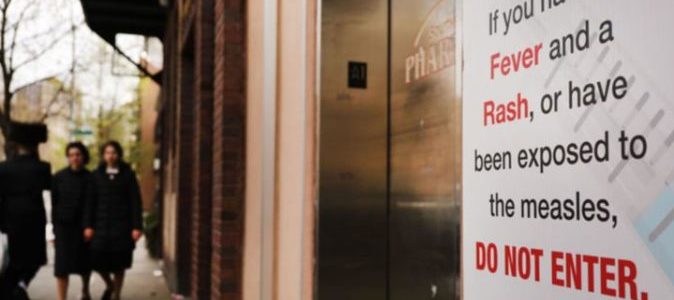For the last 10 months, the New York City Department of Health and Mental Hygiene (Health Department) has been part of the response to stop the largest measles outbreak in the United States since 1992. In NYC, there have been 642 cases confirmed as of July 29, 2019, since the outbreak began in October 2018.
In 2000, when there were only 86 cases in the United States, measles was declared eliminated from the US, meaning there was no continuous transmission of the disease for more than 12 months. Nationally, the rates of people vaccinated against measles have been very stable since the Vaccines for Children program, which began in 1994. However, even in areas with high vaccination coverage, pockets of unvaccinated people can exist and measles can spread easily in those communities. On July 10, FPHNYC invited friends and supporters to join a conversation with Dr. Jane Zucker, Assistant Commissioner for the Health Department’s Bureau of Immunization, to explore the resurgence of measles and what’s being done to stop the epidemic. Dr. Zucker’s insights are summarized below:
The majority of cases (72%) remain confined to the neighborhood of Williamsburg (ZIP codes 11205, 11206, 11211, 11249), with 93% of cases occurring in the Orthodox Jewish community. Measles is a highly contagious disease from which every case can spread to 15-18 new individuals. The median age of infected individuals is 3 years old, with 80% of confirmed cases occurring in children, of whom 90% have never been vaccinated.
On March 27, 2019, the Health Department activated its Incident Command System for the measles response to mobilize needed staff and resources throughout the agency. Onset of the disease can be prevented with post-exposure vaccinations, but they have to be administered within 72 hours after exposure, so the Health Department works around the clock. For every reported case of measles’ infection, Health Department employees contact lists of individuals who may have been exposed. The Health Department also provides alerts to providers, uses the press to spread the word, and engages in community outreach.
To end the outbreak, the Health Department has worked with and supported the work of community partners. The Health Department has placed ads in Yiddish-language publications and worked with trusted community partners such as Hatzalah, yeshivas, and women’s groups to reach community members. New services, including a hotline for requesting home vaccination, have also been introduced. Additionally, for the first time since a 1940s smallpox epidemic, a Commissioner’s Order was issued requiring vaccination. The order requires people who live, work, or go to school in delineated ZIP codes to be vaccinated with the measles, mumps, and rubella vaccine (MMR). In June, the State of New York removed the option for religious exemption to vaccination, and all schools and child care facilities must exclude unvaccinated children unless they have a medical exemption.
As a result of these efforts, reports of new measles cases have been decreasing. Between April 9 (the date the Commissioner’s order was issued) and July 29, 2019, 5,513 vaccinations were administered to children from Williamsburg, a 72% increase from the same period last year. However, activation and emergency measures remain in effect.
NYC’s strong public health infrastructure has made this comprehensive and innovative disease control response possible. For information on what you can do to support NYC’s fight against epidemics, whether communicable diseases like measles or dangerous conditions or behaviors such as obesity, opioids, and tobacco, please contact Aviva Goldstein at agoldstein@fphnyc.org.

